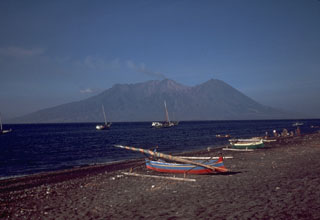Report on Sangeang Api (Indonesia) — 28 May-3 June 2014
Smithsonian Institution / US Geological Survey
Weekly Volcanic Activity Report, 28 May-3 June 2014
Managing Editor: Sally Sennert.
Please cite this report as:
Global Volcanism Program, 2014. Report on Sangeang Api (Indonesia) (Sennert, S, ed.). Weekly Volcanic Activity Report, 28 May-3 June 2014. Smithsonian Institution and US Geological Survey.
Sangeang Api
Indonesia
8.2°S, 119.07°E; summit elev. 1912 m
All times are local (unless otherwise noted)
PVMBG reported that during January-29 May diffuse white plumes rose at most 25 m above Sangeang Api's crater. On 30 May seismicity increased, with tremor starting at 0500 and becoming continuous at 1348. An eruption at 1555 generated an ash plume that rose 3 km and drifted W, causing ashfall over the sea. The Alert Level was raised to 3 (on a scale of 1-4). The island has no permanent settlements, and is only occupied during the growing and harvest seasons; civil authorities evacuated 135 people to the mainland. Based on satellite images, pilot observations, and the Indonesian Meteorological Office, the Darwin VAAC reported that on 30 May an ash plume rose to an altitude of 15.2 km (50,000 ft) a.s.l. and drifted 440 km E and 750 km SE.
BNPB reported that on 31 May two larger explosions occurred at 1330 and 2242. According to the VAAC, ash plumes from those explosions rose to altitudes of 13.7-15.2 km (45,000-50,000 ft) a.s.l. and drifted 280 km NW and other various directions. Later in the day the ash plumes became detached. Ashfall affected many areas in the Bima Regency on the mainland, including Wera, and prompted the evacuation of 7,328 people from four villages within a radius of 8 km from Sangeang Api. The Bima and Tambolaka airports were temporarily closed. According to a news article, all flights to and from the Darwin International Airport in Australia on 31 May were canceled.
The VAAC noted that ash plumes rose to an altitude of 4.3 km (14,000 ft) a.s.l. on 1 June and drifted W and SW. During 2-3 June ash plumes rose to altitudes of 3-4.3 km (10,000-14,000 ft) a.s.l. and drifted 45 km W.
Geological Summary. Sangeang Api volcano, one of the most active in the Lesser Sunda Islands, forms a small 13-km-wide island off the NE coast of Sumbawa Island. Two large trachybasaltic-to-tranchyandesitic volcanic cones, Doro Api and Doro Mantoi, were constructed in the center and on the eastern rim, respectively, of an older, largely obscured caldera. Flank vents occur on the south side of Doro Mantoi and near the northern coast. Intermittent eruptions have been recorded since 1512, most of them during in the 20th century.
Sources: Pusat Vulkanologi dan Mitigasi Bencana Geologi (PVMBG, also known as CVGHM), Badan Nacional Penanggulangan Bencana (BNPB), Darwin Volcanic Ash Advisory Centre (VAAC), The Guardian News

